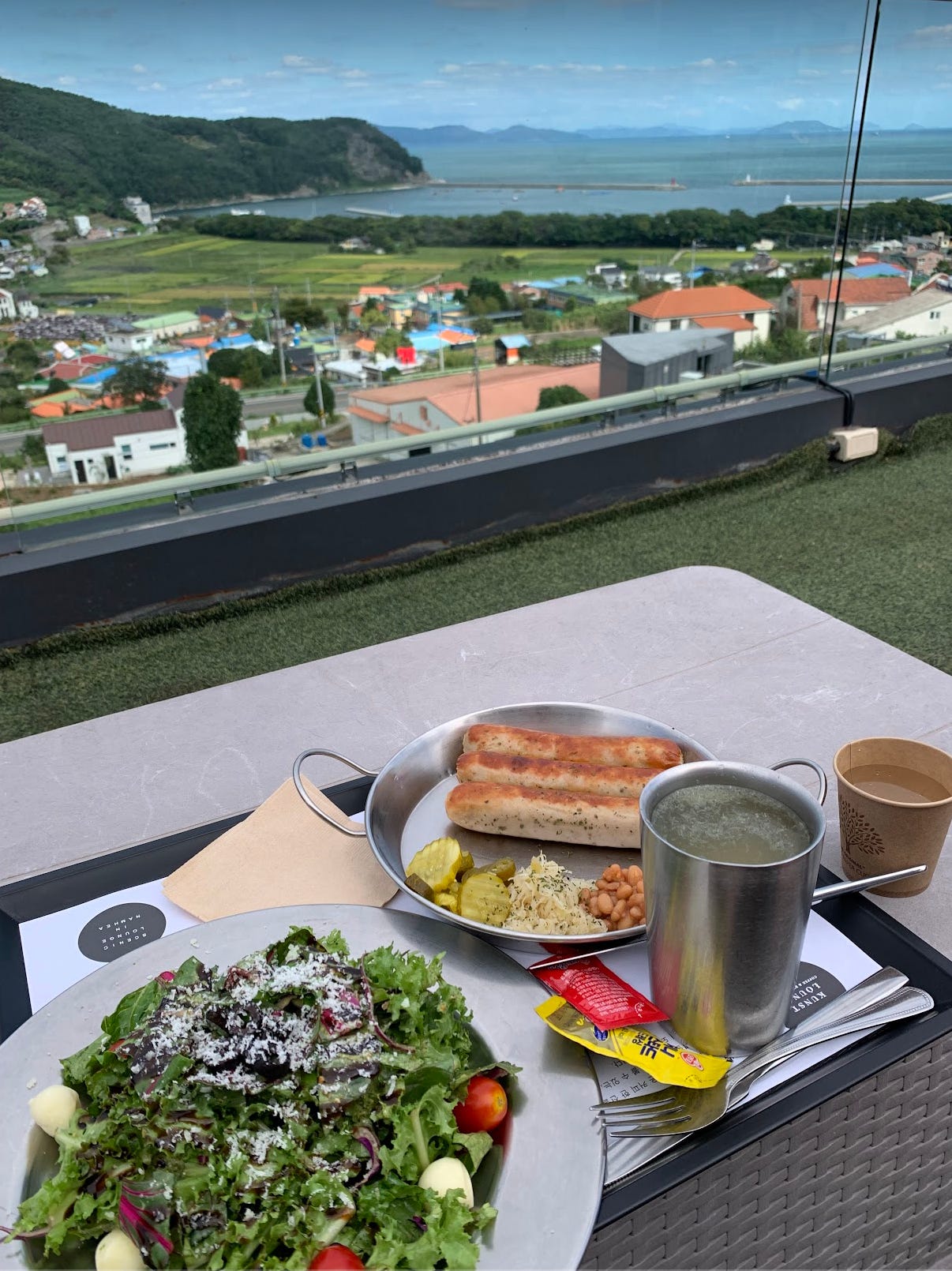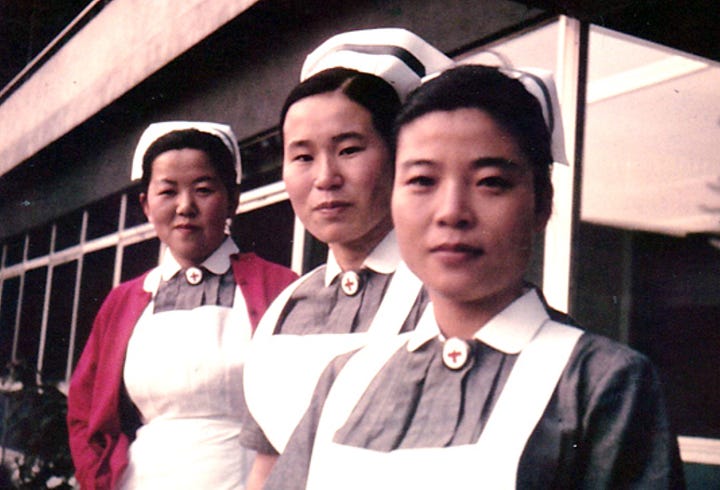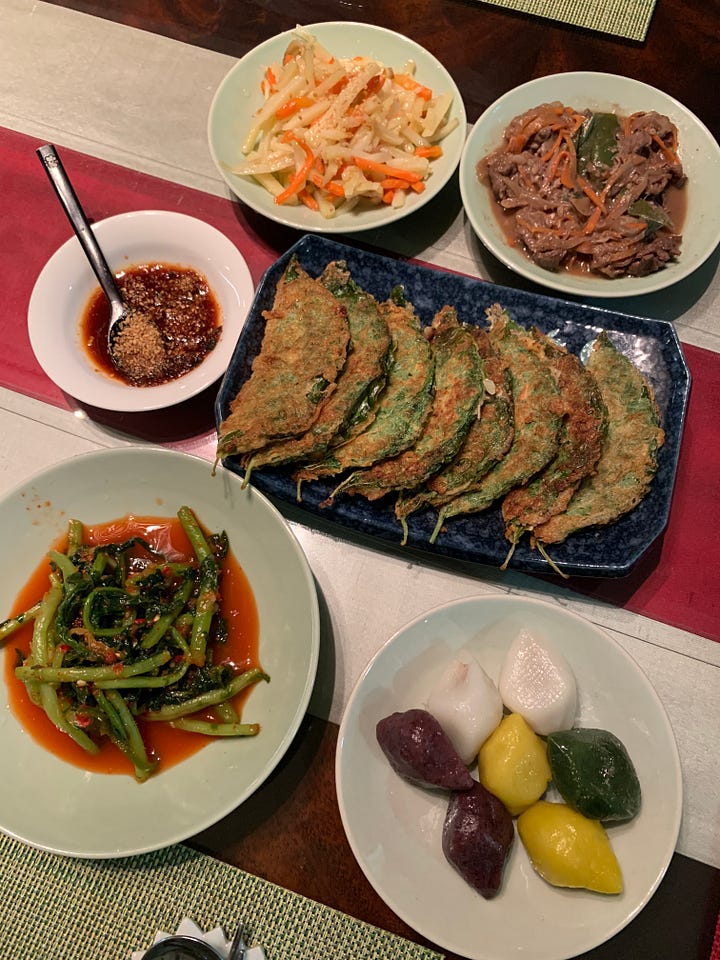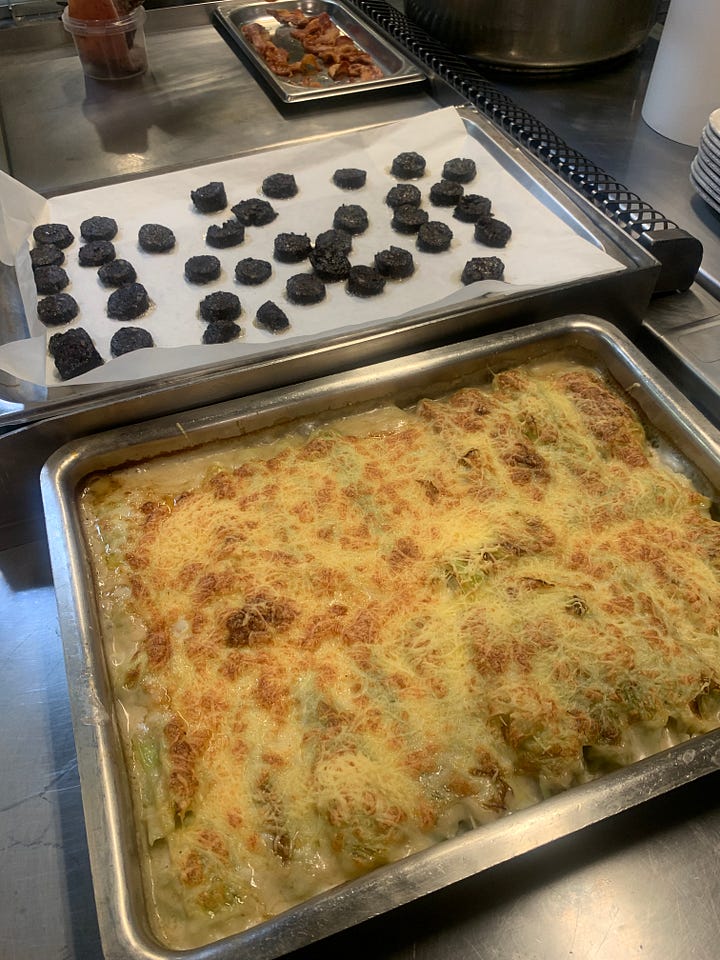Hello!
I’m finally back in Barcelona after spending most of the summer in Seoul. I love returning because I always find that not only has the city changed, but so have I. Herodotus’s quote about never walking in the same river twice applies every time I go back.1
There’s so much I want to share about what I learned about Korean history and culture, but as I often have to remind myself, this is a food newsletter, so let’s stick to that.
(But because I can’t help it, check out this footnote 👉🏼 2 👈🏼 for a word vomit of highlights!)
Now, onto today’s topic.
First, sausages in Namhae German village
Namhae (남해) is an island in the country’s southern archipelago. It’s a place I’ve hardly explored, but this year my mom and I had the chance to spend a day there hopping around the island’s many charms. One such place was the Namhae German village.

This isn’t the only “European” village I’ve been to in Korea (Petite France is a thing), but it certainly has the most fascinating story. In the 1960’s, West Germany ran into a labor shortage in the midst of its reconstruction, so they looked to South Korea as a source of cheap labor. The two countries signed the Korea-Germany Workers' Recruitment Agreement in 1963, and between 1960 and 1977, 7,936 miners and 11,057 nurses from Korea were dispatched to West Germany.3
Korea suffered heavily from unemployment and poverty at the time, so this was the perfect opportunity for people to move abroad and earn wages in a stronger currency.


Excerpt from an article in the Sungdae Shinmun4:
"Kim Chun-dong, the president of the Korean Association of Nurses and Nursing Assistants for Miners Dispatched to Germany, who worked as a miner in Germany for three years from 1977, recalled, “I felt the limits of humanity working in a mine shaft 1,000 meters underground, lower than my height, enduring 40℃ heat.” He also said, “The 30kg equipment, which was made to fit the large physiques of Germans, was too heavy for Koreans who weighed less than 60kg at the time.”
Na Hye-sim, a senior researcher at our school’s Institute of East Asian History, also said, “In the case of nurses, due to differences in nursing culture between Germany and Korea, they performed physical labor such as cleaning bathrooms and cleaning corpses, which were not nurses’ jobs in Korea.”
Today, many of them have resettled in Namhae’s German village. In fact, the local government has provided subsidies for former workers to settle there, and many of them have turned their properties into vacation homes for tourists.
Thanks to them, we lucky tourists have a beautiful spot to take in archipelago views, homemade German bratwursts, and the best pretzels around. 🥨🌭🍺

Second, dakgalbi (닭갈비)
Dakgalbi, or spicy chicken cooked on a communal iron pan, is one of my absolute favorite Korean dishes.
I have a new perspective on chicken in Korea after watching Korean Fried Chicken Rhapsody on Netflix. It’s a fascinating show, especially when they talk about how when Kentucky Fried Chicken entered South Korea in the 70’s, the most enthusiastic customers were women.
Why? Because before that, families shared entire chickens, and males usually ended up with the most meaty cuts. KFC, on the other hand, let women choose to buy only drumsticks.
Maybe I love dakgalbi so much because it only ever consists of a chicken’s prime cuts, which makes it a real treat. It’s basically the food of women’s liberation. And it’s delicious. What more does one need in life?


And finally, Korean desserts with a contemporary twist
Nothing delights me more than to see Korean classics reinterpreted in new formats. Perhaps the easiest place to see the dynamism of Korean food innovation is in desserts.
Scooper in Seochon (the neighborhood west of Seoul’s main palace Gyeongbukgung) is a perfect example of this. I was particularly ecstatic to find their mugwort (a leaf native to Korea) ice cream, which is a flavor typically reserved for rice cakes, side dishes, and other savory preparations. Their gelato version was ✨divine✨ - like the best of Italy and the best of Korea in a single bite. The sweet pumpkin and rice were close seconds.
I also sat for a coffee chat with the CEO of Goyodo, a business launched this year that’s reimagining the traditional dessert known as yakgwa. (Thank you to Ethan for answering my cold email!) My family received a box of Goyodo treats for Chuseok, and I was thrilled to see this new take on yakgwa using both Korean and Western flavors. Ethan, a Gwangju native, is only in his early 30s and left his private equity job to start Goyodo. He has big ideas for the company, and I can’t wait to see them grow.

👩🏻🍳 Cooking tips
Let’s talk about wrapping things in leaves. I am new to it myself, but I think it is a lovely alternative to wrapping things in dough. They’re lighter, so you leave more room in your stomach for the good stuff - the filling.5
📍 Technique #1 - pan-frying: I recently tried making perilla leaf jeon. Perilla leaves are common in Korean cuisine and have a distinctly bitter taste that sounds unpleasant, but are actually quite delicious when paired with the right things.
You can protect the leaves from burning by coating them first in flour and then in beaten eggs. Then, throw them into a greased pan and cook until done.


📍 Technique #2 - blanching + baking: Earlier this year, I took a class on seasonal cooking here in Barcelona. Each day focused on a new vegetable, and on cabbage day, we made canelons wrapped in cabbage leaves, instead of the conventional flour dough.
We blanched the cabbage leaves in water until soft, added filling, rolled them up, sprinkled cheese on top, and baked the whole thing. It was a beautiful way to highlight humble in-season cabbages.


📍 Technique #3 - raw: It’s common in Korean cuisine to wrap pieces of meat, rice, tofu, etc. in leaves, add some sauce, and eat like a taco. We call it ssam (literally “wrap”).
I took the photo below from a restaurant specializing in bulgogi (marinated beef). I loved that this restaurant had a 🍃self-service leaf bar🍃, which was filled with 6 different types of fresh leaves to wrap your meat. The sign even adds each leaf’s respective health benefits. What a lovely way to promote leaf eating!
3️⃣ Barcelona tips for you
The All Those Food Market, a festival of artisan products and gastronomy, is happening at Fòrum, Plaza Leonardo da Vinci this weekend (and there’s workshops!). 5eur to enter.
Looking for a good esmorzar de forquilla? Look no further than EsmorzApp, a collaborative map run by journalist Albert Molins with restaurants all over els països Catalans where you can try a very hearty Catalan breakfast.
Jenny Chih-Chieh Teng of Mellow Sheng is hosting a workshop about cooking with tofu at the Centre Cívic Vil·la Urània on November 28 from 18-20h. (More information, as long as other workshops, here on page 20.)
🌏 Language corner
I left Korea too early this time to see all the rice fields turn bright yellow, but here’s a beautiful expression in their honor:
벼는 익을수록 고개를 숙인다, or “the more the rice plant ripens, the more it bends its head"
In other words, stay humble as you rise up, just like this rice plant: 🌾
It’s nice to be back in Barcelona! I’m thrilled to see roasted chestnut vendors already out on the streets. I met some Catalans while hiking Dobongsan in Seoul, and one of them mentioned that seeing chestnut vendors in Korea made her feel a special connection to home.
I feel the same way, in the opposite direction. I’ll be first in line when the one near me opens up. 🌰
Until next time,
Janey
"No man ever steps in the same river twice, for it is not the same river and he is not the same man.”
The city of Seoul offers 20+ free walking tours available in Korean and English. I did a whopping 7 of them, and can’t wait to return for more. My favorites: Changgyunggung Palace, Seochon, and Seongbuk-dong.
Flowers of Fire: The Inside Story of South Korea's Feminist Movement and What It Means for Women's Rights Worldwide by Hawon Jung is a must-read. It will horrify and infuriate you, but you will finish it inspired.
Korea: A New History of South and North by Victor Cha and Ramon Pacheco Pardo is a helpful overview of modern Korean history, written by people who’ve been in the room for recent historic moments.
There is breathtaking rock climbing in Seoul (just ask these guys), and climbing is becoming increasingly popular. Seoul even held 2024’s last IFSC Climbing World Cup at the Gangnam Sports Climbing Center this October. I think it’ll be worth following Korean climbers over the next decade.
The National Hangeul (= Korean alphabet) Museum is stunning. And free.
Same as footnote 3.
I understand that ‘wrappers’ can be just as exciting as filling, especially in the world of dumplings and dim sum, but that may have to be a topic for another day.






Beautiful summary of your trip in Korea! Enjoyed reading it!